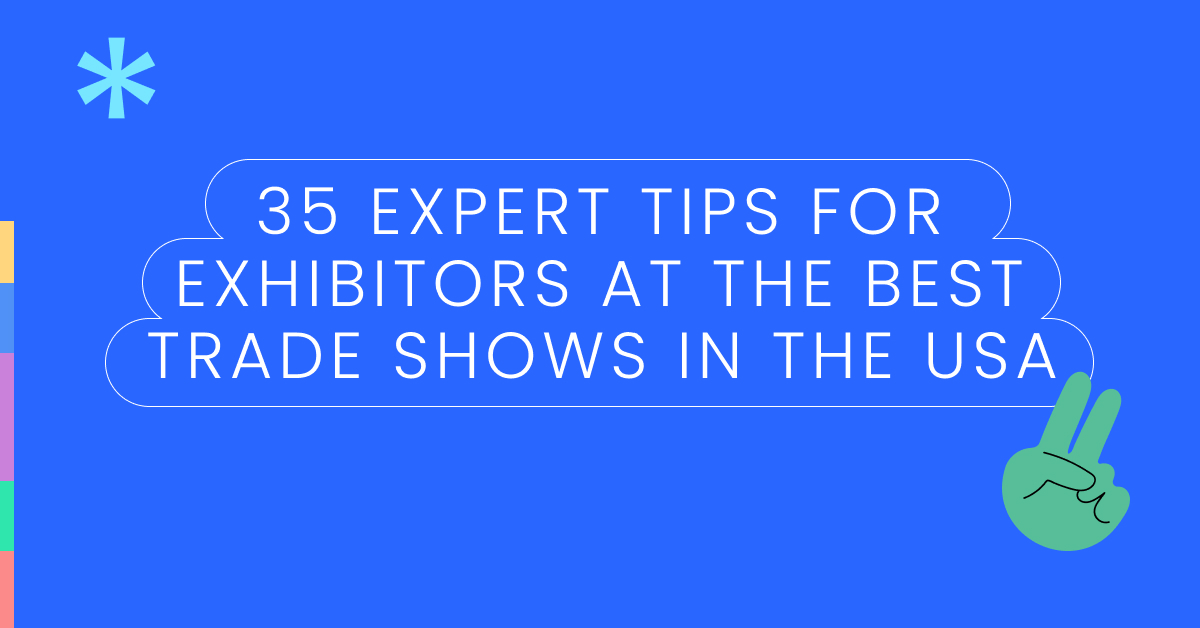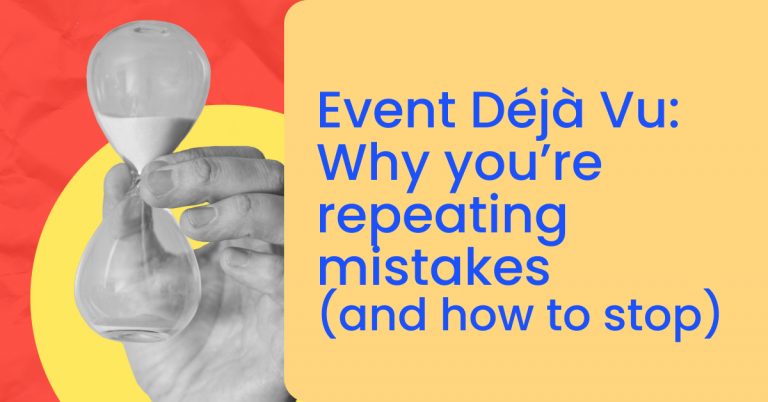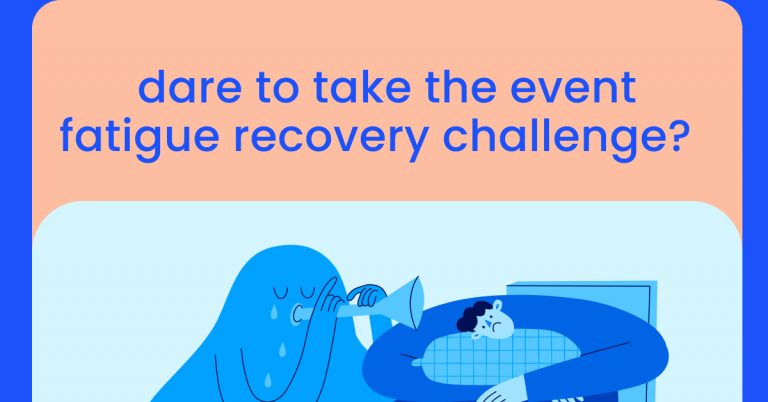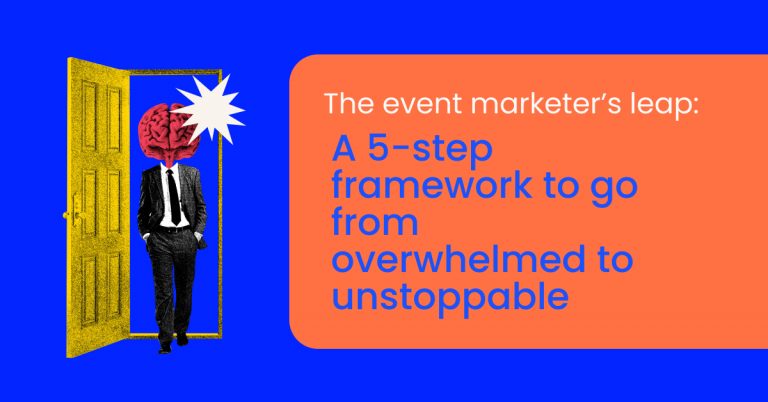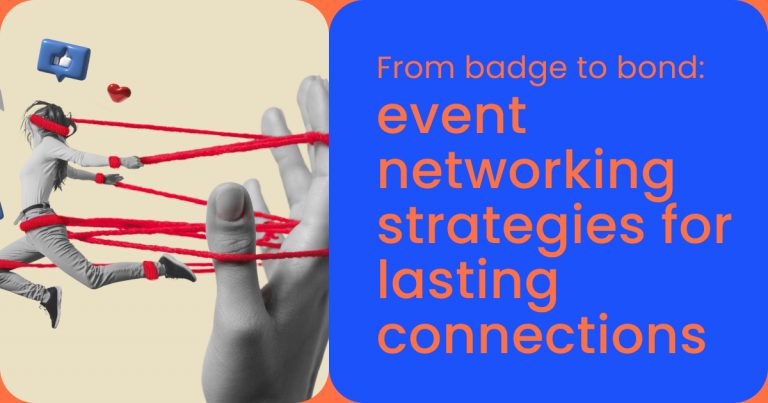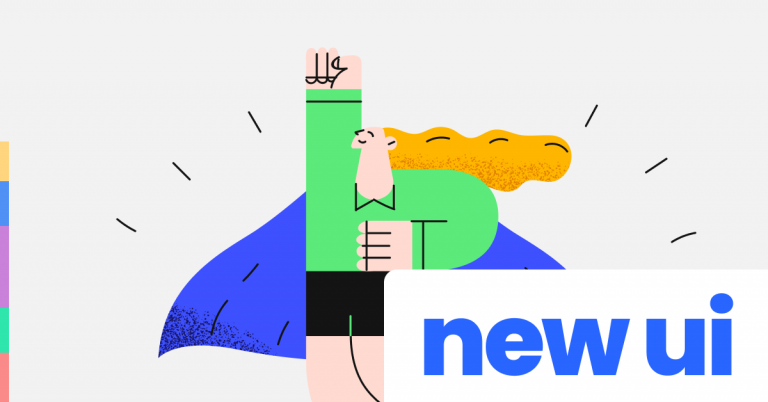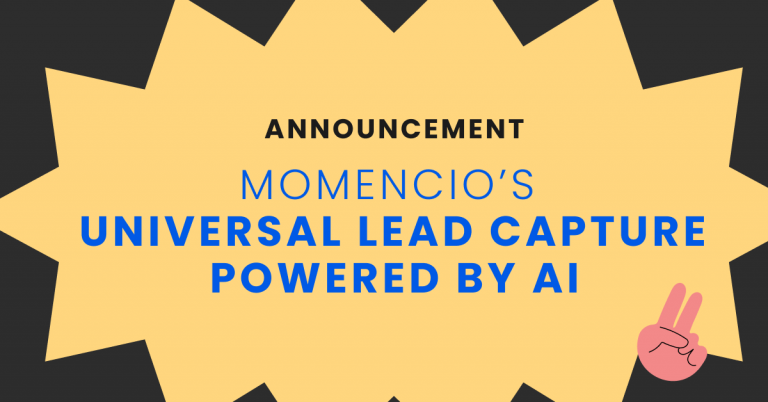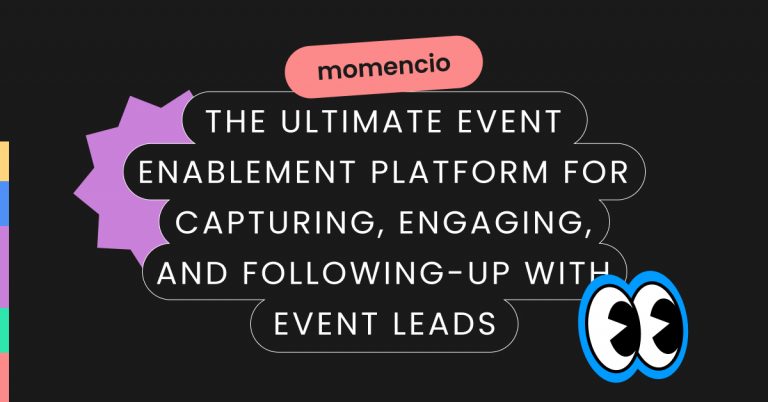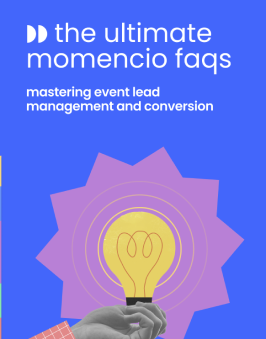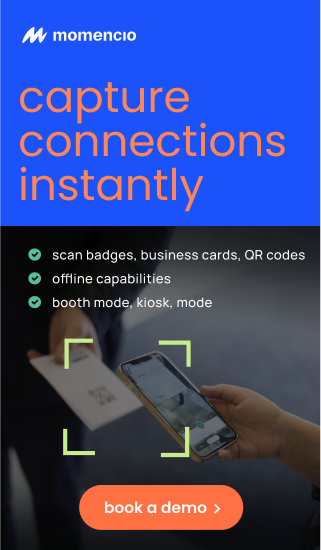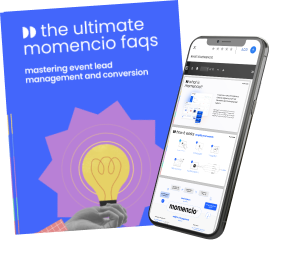Success at a trade show is never a matter of chance. It requires a well-thought-out strategy that integrates pre-show preparation, in-event execution, and post-show follow-up. Some of the best trade shows in the USA like CES, IMEX, and NRF attract thousands of potential customers, but standing out among the competition is challenging.
A study revealed that 81% of trade show attendees have purchasing authority, making trade shows in USA a goldmine for lead generation. However, the gap between average and top exhibitors lies in their approach. Are they meticulously choosing the right trade show? Are they engaging visitors meaningfully? And crucially, are they leveraging every lead post-event?
This guide answers the most pressing questions exhibitors face, revealing insights from seasoned trade show veterans who have mastered the art of captivating audiences and achieving measurable ROI.
35 expert tips for succeeding at the best trade shows in the USA
1. How do I determine if a trade show is right for my business?
To determine if a trade show aligns with your business, start by identifying your primary objectives—are you aiming to generate leads, boost brand visibility, or network with industry leaders? Once your goals are defined, assess the trade show’s relevance to your industry and audience. Ask organizers for detailed attendee demographics, including industries, roles, and purchasing power. This ensures the show attracts the right people for your business.
Review past exhibitor experiences through testimonials or case studies provided by the organizers. Check for metrics such as booth traffic, attendee engagement levels, and conversion rates. Also, investigate whether competitors or other key players in your industry participate; this can indicate the event’s importance. However, if competitors dominate the space, explore whether a more niche event might allow you to stand out.
Budget is another critical factor. Compare the projected costs of participation—booth space, travel, marketing materials, and giveaways—with the potential return on investment. Smaller, focused trade shows can sometimes yield better leads than larger ones with a broad audience.
Finally, examine the event’s reputation in your industry. Check online reviews, social media activity, and organizer credentials to ensure it aligns with your goals. A well-researched decision can save resources and amplify your success.
2. What are the must-have elements in a trade show booth design?
An effective trade show booth design isn’t just visually appealing—it’s a strategic tool to draw in your audience and communicate your brand’s value. Start by ensuring your booth visually represents your brand identity through consistent colors, logos, and impactful imagery. The design should be clean and professional, avoiding unnecessary clutter that overwhelms visitors.
Open layouts are essential for encouraging foot traffic. Avoid using barriers or closed-off spaces that deter attendees from entering. Include interactive elements like touchscreens, product demos, or VR/AR experiences to create a memorable visitor journey. These elements should align with your business’s unique selling points, helping you stand out from competitors.
Clear signage is critical. Use concise and engaging language to highlight your value proposition—what problem you solve or what benefit you offer. Signage should be placed at eye level and visible from a distance.
Comfortable spaces for deeper engagement are also key. Provide seating areas or semi-private corners for meaningful discussions, ensuring they are functional yet visually integrated with the design. Finally, lighting plays an underrated role; use a mix of bright, focused lighting for products and softer ambient lighting to create a welcoming atmosphere. A well-designed booth sets the stage for meaningful interactions and strong ROI.
3. How can I effectively promote my trade show participation beforehand?
Pre-show promotion is pivotal to your trade show success. A well-executed campaign ensures that your booth attracts the right attendees. Start by leveraging email campaigns targeted at existing clients, prospects, and industry contacts. These emails should include event details, your booth location, and an incentive—such as an exclusive product demo or giveaway—to visit your booth.
Social media is another powerful channel. Use event-specific hashtags to join the conversation and share teasers, such as behind-the-scenes booth setup photos or countdown posts. Paid ads on LinkedIn, Facebook, or Instagram can target specific audiences and amplify your reach.
Consider collaborating with the event organizers to gain visibility on their website, newsletters, or attendee guides. Many events allow exhibitors to feature in pre-show content, boosting your profile.
Offering incentives is another effective strategy. For instance, you could run a contest or offer early meeting bookings for attendees who RSVP. Personalized direct mail campaigns can also leave a lasting impression in the digital age.
Finally, establish a pre-show follow-up plan. Confirm meetings with potential clients and influencers, and ensure your team is aligned on messaging and expectations. Proactive promotion builds anticipation and sets the stage for meaningful engagements at the event.
4. What kind of giveaways attract the most attention at the best trade shows in the USA?
Effective trade show giveaways are those that resonate with your target audience and reflect your brand’s value. Functional items like portable chargers, branded notebooks, or reusable water bottles tend to be well-received. These items not only provide utility but also ensure your brand stays visible long after the event.
Tech-related giveaways are particularly popular at the best trade shows in the USA. Consider items like wireless chargers, Bluetooth speakers, or USB drives pre-loaded with helpful resources about your product or service. If your audience is eco-conscious, sustainable options like bamboo utensils or biodegradable tote bags can create a positive impression.
The key is to connect the giveaway to your brand story. For instance, if you’re in the health and wellness sector, branded fitness bands or water bottles would align perfectly with your messaging.
Make the giveaway part of an interactive experience. Instead of handing out items indiscriminately, ask attendees to engage with your booth first—participate in a demo, take a survey, or share their contact details. This approach increases booth engagement while qualifying leads.
Remember, quality matters more than quantity. A unique, valuable giveaway will leave a lasting impact, fostering goodwill and brand recall.
5. How do I handle competitors at the same trade show?
Competitors at a trade show are inevitable, but how you handle them can make a significant difference in your success. The first step is preparation. Research which competitors are attending and analyze their offerings, messaging, and booth designs. This will help you craft a strategy to differentiate yourself effectively.
Focus on showcasing your unique value proposition. What can you offer that competitors can’t? Highlight specific benefits, features, or solutions that set you apart. For example, if your product is more affordable, emphasize cost savings; if it’s more innovative, focus on cutting-edge features.
During the event, maintain professionalism. Avoid directly criticizing competitors—it can reflect poorly on your brand. Instead, position yourself as a leader in your niche by sharing thought leadership through presentations, panel discussions, or on-booth content.
Leverage competitor presence to your advantage. Observe their strategies, booth traffic, and attendee interactions to identify gaps or opportunities. You can even network with shared prospects to position your brand as collaborative and approachable.
Finally, ensure your team is well-prepared to handle questions about competitors. Provide them with clear talking points that steer the conversation back to your strengths. A strategic, confident approach will help you stand out in a crowded trade show environment.
6. What is the best way to stand out in a crowded exhibit hall?
Standing out in a bustling exhibit hall starts with grabbing attention immediately. Focus on bold visuals—use oversized signage with concise messaging, vibrant colors, and eye-catching displays. Keep your booth design open and inviting, avoiding barriers like tables blocking the entry.
Interaction is key. Incorporate engaging activities such as live demonstrations, interactive screens, or gamified experiences. For example, create a quick contest or use a prize wheel to draw in attendees. Once you have their attention, focus on delivering value. Your team should actively approach attendees with thoughtful questions that spark curiosity and highlight how your product or service solves their pain points.
Social proof also helps. Showcase testimonials or display industry awards visibly. Use digital monitors to loop customer success stories or impressive statistics that validate your brand’s credibility.
Leverage audio and visual techniques too. Subtle music or dynamic LED displays can create a memorable atmosphere that lingers in attendees’ minds. Personal touches, like offering a customized experience or asking attendees to share their preferences, also ensure your booth leaves a lasting impression.
7. How do I ensure my booth staff is fully prepared for success?
Start by training your booth staff in key areas such as product knowledge, customer interaction techniques, and handling objections. Use role-playing sessions to simulate real-world scenarios they might encounter during the trade show.
Emphasize the importance of body language. Encourage staff to maintain open, friendly postures, make eye contact, and smile warmly when greeting attendees. Provide them with concise talking points and questions designed to engage visitors rather than overwhelm them. For instance, instead of launching into a full pitch, train your staff to ask, “What challenges are you facing in your current setup?”
Equip your team with tools. Distribute business cards, brochures, or digital devices preloaded with product demos. For technical questions beyond their scope, ensure they know the escalation process to connect attendees with specialists.
Motivate them by setting clear goals, such as lead quotas or scheduled meetings. Keep their energy up during the event by offering short breaks and refreshments. Finally, conduct a daily debriefing to gather feedback and refine strategies for the remaining days.
8. How can I attract key decision-makers to my booth?
To attract decision-makers, focus on creating an experience tailored to their priorities. Start with pre-show outreach. Use LinkedIn or email to send personal invitations, highlighting how your booth offers solutions specific to their business challenges. Mention exclusive opportunities like one-on-one demos or personalized consultations.
At the booth, design an executive-friendly environment. Use private meeting areas or lounges for confidential discussions. Ensure these spaces reflect a professional tone, with comfortable seating and refreshments. Decision-makers often value efficiency, so streamline your presentations to focus on high-impact results. Use compelling case studies or statistics that showcase your success in solving similar problems.
Time matters to decision-makers. Train your staff to identify attendees wearing executive badges and prioritize engaging them quickly. Offer exclusive content like whitepapers or access to high-level insights that aren’t available to the general crowd. Finally, follow up immediately after the event with tailored solutions to solidify their interest.
9. What role does social media play in trade show success?
Social media amplifies your presence and helps you connect with attendees before, during, and after the event. Before the show, announce your participation across platforms like LinkedIn, Twitter, and Instagram. Share teaser posts showcasing your booth, schedule, and any giveaways or exclusive demos. Use event hashtags to ensure your content reaches a broader audience.
During the trade show, post live updates. Share photos of your booth, short videos of ongoing activities, or live streams of key moments like product launches. Encourage attendees to tag your brand when posting about your booth. Gamification also works—create challenges like photo contests with prizes for those who share posts featuring your booth.
After the event, keep the conversation going by posting highlights and following up with connections you made. Tag individuals or companies you engaged with to nurture relationships. Social media is an ongoing channel to amplify your ROI long after the event ends.
10. How do I measure ROI from a trade show?
Measuring ROI starts with setting clear objectives before the event. Track key metrics like leads generated, booth traffic, and scheduled meetings. Use lead scoring systems to prioritize high-value prospects and calculate their potential revenue contribution.
After the show, analyze lead conversion rates. For instance, how many of the leads captured converted into actual deals? Compare this against the total investment in the trade show, including booth costs, travel, and marketing expenses.
Digital tools make this easier. Use CRMs integrated with lead capture tools to monitor the journey of every lead. Analyze engagement metrics like how many attendees viewed follow-up emails, visited microsites, or downloaded resources.
Additionally, gather qualitative feedback from your team. Were there missed opportunities? What strategies worked best? Use these insights to refine your approach for future events, ensuring your event ROI improves with each trade show.
11. How can I create a trade show strategy tailored to my brand?
Building a brand-centric trade show strategy starts with identifying your unique value proposition. What sets your business apart? Use this as the foundation for your messaging, booth design, and engagement tactics.
Develop a consistent theme that reflects your brand identity. For example, if your brand emphasizes innovation, incorporate cutting-edge technology like AR/VR demos or interactive displays into your booth. Ensure all visual elements, from banners to giveaways, feature your brand colors and logo prominently.
Tailor your strategy to your audience. Research the trade show’s attendees and create messaging that addresses their pain points. For instance, if the audience is made up of IT professionals, focus on how your solutions enhance efficiency and reduce costs.
Leverage storytelling to humanize your brand. Share customer success stories or feature live testimonials at your booth. Finally, align your pre-show promotion, booth activities, and post-event follow-ups with your brand message to create a cohesive experience. This ensures attendees leave with a strong, consistent impression of your business.
12. How do I balance selling and networking at a trade show?
Effective trade show participation involves balancing your sales objectives with genuine networking efforts. Start by categorizing your priorities. Assign team members to focus on each area: some can actively pitch your products, while others engage in more relationship-driven conversations.
When networking, prioritize listening over speaking. Ask attendees about their business challenges and goals. For instance, a simple question like, “What brings you to this event?” can uncover valuable insights. Avoid jumping into a sales pitch too early; focus on building trust and rapport.
For selling, schedule product demos or presentations strategically. Use tools like calendars or scheduling apps to manage time efficiently, ensuring you balance scheduled sales activities with organic networking opportunities.
Document every interaction using lead capture tools, whether the contact is a potential customer or a valuable industry connection. Follow up post-show with tailored communication, emphasizing either a sales angle or partnership opportunity depending on the relationship established.
13. What should I include in my trade show follow-up communication?
Post-show follow-up should be personalized and timely. Start by referencing the attendee’s visit to your booth. For instance, you could say, “It was great discussing [specific topic] with you at [event name].” This immediately establishes relevance and reminds them of your interaction.
Provide value in your communication. Share resources such as whitepapers, case studies, or product guides that address the attendee’s pain points. Include links to relevant content like videos of your product demos or a personalized microsite tailored to their interests.
If you captured specific information about their needs during the event, reference it. For example, “You mentioned struggling with [specific challenge]. Here’s how our solution can help.” This level of personalization significantly boosts engagement rates.
Always include a clear call-to-action. Whether it’s scheduling a follow-up meeting, signing up for a webinar, or downloading additional materials, guide them toward the next step in the sales funnel.
14. How do I handle difficult questions from attendees at my booth?
Handling tough questions requires preparation and poise. Train your booth staff to anticipate common challenges or objections attendees might raise. For instance, questions about pricing, competitors, or implementation difficulties should have pre-drafted responses.
Stay honest and professional. If an attendee asks about a feature your product doesn’t offer, acknowledge it without defensiveness. Pivot the conversation toward your strengths by saying something like, “While we don’t have that feature, here’s how our solution delivers value in a different way.”
When faced with highly technical or specific inquiries, escalate appropriately. Ensure your team knows who to involve for detailed explanations, such as technical experts or product managers.
Use difficult questions as an opportunity to engage deeper. Sometimes, attendees who ask challenging questions are genuinely interested and want to ensure your solution meets their needs. By addressing their concerns confidently and transparently, you can turn skeptics into advocates.
15. How do I manage booth traffic during peak hours?
Managing high traffic at your booth requires a streamlined approach to ensure every visitor feels engaged without overwhelming your team. Start by setting up designated zones within your booth. For example, create separate areas for product demos, casual conversations, and one-on-one consultations.
Use a triage system to qualify visitors quickly. Train staff to ask targeted questions like, “What are you hoping to achieve at this event?” This helps identify high-priority leads who need immediate attention.
Deploy technology to assist with crowd management. Use digital sign-ups for demos or presentations to minimize wait times. Display live schedules on screens so attendees can plan their visits efficiently.
Ensure your booth is well-staffed during peak hours. Assign specific roles to team members—for instance, some can focus on crowd control while others handle detailed discussions. Providing self-service options like touchscreens or product brochures for casual visitors ensures everyone receives attention.
Finally, maintain energy levels by scheduling staff rotations and providing refreshments. A well-organized booth not only handles crowds effectively but leaves visitors with a positive impression of your brand.
16. How do I measure success beyond lead generation at trade shows?
Success at trade shows isn’t just about capturing leads—it involves evaluating broader goals such as brand awareness, customer engagement, and market insights. Start by assessing booth traffic. Monitor how many attendees visited your booth and engaged with your displays or activities. Use tools like footfall counters, heatmaps, or RFID tracking for accurate data.
Another metric to consider is brand visibility. Did your booth attract attention from the media, influencers, or key industry players? Track mentions on social media, blog posts, or event coverage that highlight your participation.
Engagement quality also matters. Measure how many meaningful conversations your team had and how attendees interacted with your content, such as attending demos or participating in activities. For long-term impact, gauge attendee sentiment by sending post-show surveys to visitors.
Finally, monitor market intelligence. Trade shows are opportunities to gather competitor insights and understand emerging industry trends. Success isn’t just in closing deals but in the knowledge you gain to refine your strategies. By taking a holistic view, you can uncover the full value of your trade show participation.
17. How do I train my team to qualify leads effectively?
Effective lead qualification starts with a clear understanding of what constitutes a high-value prospect for your business. Train your team to identify these prospects by asking specific, open-ended questions like, “What challenges are you facing in [specific area]?” or “What solutions are you currently exploring?”
Provide staff with a lead scoring system. For example, assign points based on factors like the attendee’s job title, buying authority, budget, or timeline for purchasing. This system helps prioritize prospects who are more likely to convert into customers.
Use role-playing during training sessions to simulate real conversations. For instance, one team member can act as an attendee, presenting different scenarios, while others practice asking qualifying questions.
Equip your team with tools such as lead capture apps that allow them to tag or categorize leads in real time. After the show, this data can guide your follow-up strategy. Ensure your team knows how to strike the right balance—engaging visitors without making them feel interrogated. A well-prepared team can identify the best opportunities, ensuring your resources are spent on leads that truly matter.
18. What are the best ways to maximize post-show follow-ups?
Post-show follow-ups are essential for converting trade show leads into lasting customers. Start by segmenting your leads into categories based on priority. For example, high-value prospects might require immediate follow-up calls, while others can receive targeted email campaigns.
Personalization is critical. Reference specific details from your booth interaction. For instance, “It was great discussing how our product can improve your [specific process]. Here’s a case study you might find helpful.” Use CRM tools to integrate this data into your follow-up communications.
Timing also plays a role. Reach out within 48 hours while the event is still fresh in the attendee’s mind. If the lead has already shown interest, schedule a product demo or one-on-one consultation within the first week.
Leverage multiple channels for follow-ups, such as emails, social media messages, or direct mail for a memorable touch. Use analytics to track engagement metrics like email open rates or content downloads, refining your approach based on what resonates with each lead. Post-show follow-ups are where trade show success is truly cemented.
19. How do I use data to improve trade show performance?
Data is a powerful tool for optimizing trade show strategies. Start by collecting metrics during the event, such as booth traffic, engagement rates, and lead quality. Use tools like badge scanners or lead capture apps to gather detailed visitor information.
Post-event, analyze this data to uncover patterns. For example, which activities attracted the most visitors? Which conversations resulted in the highest-quality leads? By identifying what worked, you can replicate and refine these tactics for future shows.
Feedback is another valuable data source. Use surveys to gather insights from both attendees and your booth team. Ask questions like, “What did you find most engaging about our booth?” or “How can we improve your experience next time?”
Combine qualitative and quantitative data to build a complete picture. Use these insights to optimize every aspect of your trade show participation, from booth design to staff training and follow-up strategies. Over time, a data-driven approach ensures consistent improvement in your trade show ROI.
20. How do I create an interactive experience at my booth?
An interactive booth experience captures attention and keeps visitors engaged longer. Start with technology. Incorporate touchscreens, AR/VR demonstrations, or gamified elements like trivia quizzes or scavenger hunts. These features create a hands-on experience that makes your booth memorable.
Personalization adds another layer. Use tools like digital kiosks to let visitors explore products tailored to their needs. For example, a virtual product configurator can allow attendees to customize solutions based on their preferences.
Live demonstrations or workshops are also highly engaging. Invite attendees to participate in activities, such as testing your product or attending a short tutorial.
Lastly, use giveaways strategically. Create a challenge—such as earning a reward after completing a quiz or scanning a QR code—encouraging deeper engagement with your booth. By designing an interactive journey, you’ll not only stand out but also create lasting connections with your audience.
21. How do I set realistic goals for my trade show participation?
Setting realistic trade show goals requires a clear understanding of your objectives and available resources. Start by defining the purpose of your participation. Are you aiming to generate leads, strengthen brand awareness, or launch a new product? Each goal requires different metrics for success. For instance, lead generation might focus on the number of qualified contacts, while a product launch could emphasize booth traffic or media mentions.
Break your goals into specific, measurable targets. Instead of saying, “We want more leads,” aim for, “We will capture 150 qualified leads over three days.” Use past trade show data as a benchmark. If you generated 100 leads at a similar event, a 50% increase may be ambitious yet achievable.
Consider your budget and resources. If your booth is small or your team is limited, set goals that align with your capacity. Ensure your goals are time-bound, focusing on both during and post-event outcomes. For example, “Schedule 10 follow-up meetings within two weeks of the event.”
Regularly evaluate progress. During the event, review metrics like booth traffic or engagement levels to adjust your strategies if necessary. Realistic, well-defined goals ensure your efforts remain focused and measurable.
22. How can I use storytelling to connect with attendees?
Storytelling is a powerful tool for engaging trade show attendees on a deeper level. Begin by crafting a narrative that highlights your brand’s mission, challenges, and successes. Instead of overwhelming attendees with facts, present a relatable story that positions your business as a solution to their problems.
At the booth, integrate storytelling into every element. Use visual media like videos or digital displays to showcase customer success stories or product journeys. For instance, a case study could demonstrate how your solution helped a client save time or reduce costs.
Encourage your staff to weave storytelling into their conversations. Instead of saying, “Our product increases efficiency,” try, “One of our clients reduced production time by 30% using this product—here’s how.” Personal anecdotes humanize your brand and build trust.
Leverage interactive elements. Create opportunities for attendees to experience your story firsthand, such as through live demos or hands-on activities. Wrap up every story with a clear call-to-action, helping attendees see themselves as the next chapter in your brand’s success.
23. How do I effectively follow up with media contacts after a trade show?
Following up with media contacts is crucial for amplifying your trade show exposure. Start by organizing the list of journalists and influencers you engaged with during the event. Use tools like a CRM or spreadsheet to log their contact details, publication, and areas of interest.
Within 24 to 48 hours after the show, send a personalized email thanking them for their time. Reference specific discussions you had at the booth to show you were paying attention. For example, “It was great discussing the future of sustainable packaging with you during the event.”
Provide value in your follow-up. Share press releases, high-quality images, or exclusive access to product updates relevant to their audience. If you offered an interview or product demo during the event, include a summary of key points or links to supplementary materials.
Offer ongoing collaboration opportunities. Invite them to upcoming product launches, webinars, or exclusive briefings to keep them engaged with your brand. Tailored, timely follow-ups help build strong relationships with media professionals, increasing the likelihood of coverage.
24. What are the best ways to attract attendees to presentations at my booth?
Driving traffic to booth presentations requires a combination of pre-show promotion and on-site engagement. Start by advertising your presentation in advance through email campaigns and social media posts. Use the event’s official channels, such as hashtags or exhibitor directories, to increase visibility. Highlight what attendees will gain—whether it’s expert insights, exclusive product demos, or giveaways.
On-site, use digital signage or displays to promote upcoming presentations. A countdown timer or looping video can create urgency and anticipation. Consider hiring an emcee or using live announcements to draw attention.
Timing matters. Schedule presentations during peak traffic hours and avoid overlaps with major conference events. Use interactive formats like Q&A sessions or live demos to encourage participation. For added incentive, offer perks like priority seating or exclusive swag for attendees who stay for the full presentation.
Finally, make presentations easily accessible. If your booth is large, ensure clear pathways and visible signage lead attendees to the area. An engaging presentation can become the highlight of their event experience.
25. How do I foster long-term relationships with trade show leads?
Building lasting relationships with trade show leads starts with meaningful engagement at the event. Focus on understanding their needs rather than delivering a one-size-fits-all pitch. Collect detailed notes on each lead’s challenges and interests using digital tools or CRM apps.
After the show, send personalized follow-ups referencing your booth interaction. Include relevant content, such as whitepapers, industry reports, or product videos that address their specific concerns. Avoid generic messages—tailor every communication to show you understand their pain points.
Stay consistent. Regularly reach out with valuable updates, such as new product launches, webinars, or exclusive offers. Use channels they prefer, whether email, LinkedIn, or phone calls.
Consider implementing a nurturing campaign. Segment leads into categories based on their readiness to buy and deliver targeted content over time. For instance, high-priority leads might receive invitations to consultations, while less urgent ones get educational resources.
Finally, focus on building trust. Position yourself as a partner rather than a vendor by offering solutions tailored to their goals. Consistent, meaningful interactions will ensure leads see your brand as a long-term ally.
26. How do I determine the ideal size and layout for my trade show booth?
Choosing the right booth size and layout depends on your goals, budget, and the type of experience you want to create for attendees. Start by defining your objectives. If your primary focus is product demonstrations, allocate space for a dedicated demo area. If networking is key, include seating arrangements for private discussions.
Assess the trade show’s audience and traffic patterns. Larger booths may attract more attention in high-traffic areas, but smaller, well-designed booths in strategic locations can also be effective. Choose a layout that allows for smooth attendee flow. Open layouts with multiple entry points are inviting and prevent overcrowding.
Consider vertical space. Use tall banners or hanging signage to make your booth visible from across the exhibit hall, especially in crowded spaces. Ensure every inch of your booth serves a purpose—whether it’s showcasing products, displaying brand messaging, or hosting conversations.
Finally, factor in staffing needs. The booth size should comfortably accommodate your team and visitors without feeling cramped. A well-planned layout maximizes engagement opportunities while maintaining a professional, welcoming atmosphere.
27. How do I track booth traffic and visitor engagement during the show?
Tracking booth traffic and engagement requires the right mix of technology and observation. Start with tools like RFID trackers or footfall counters to measure how many attendees visit your booth. Badge scanners can capture detailed visitor data, including names, job titles, and companies.
Leverage mobile apps that integrate with CRMs to record real-time interactions. These apps allow your team to categorize leads based on engagement levels or interests. For example, a prospect who asks for a demo can be marked as a high-priority lead.
Observation also plays a role. Assign team members to monitor visitor flow and identify peak traffic times. This data helps you adjust staffing or activities to better manage crowds.
Engagement-specific tools like heatmaps can show which booth areas attract the most attention. Use these insights to refine your layout or improve content placement. Post-event, analyze the data to identify trends and areas for improvement, ensuring a more targeted approach for future shows.
28. What should I include in my trade show survival kit?
A well-stocked trade show survival kit ensures your team stays prepared and productive. Start with essential office supplies like pens, notepads, tape, and scissors. Include backup copies of marketing materials, such as brochures or business cards, to avoid running out mid-event.
For technology, bring portable chargers, extension cords, and adapters. A reliable Wi-Fi hotspot can be invaluable if the venue’s connection falters. Test all devices, including laptops and tablets, beforehand to ensure smooth operation.
Don’t forget health and comfort items. Pack water bottles, snacks, and over-the-counter medications like pain relievers. Comfortable footwear is crucial, as your team will spend long hours on their feet. Bring a first aid kit for minor emergencies.
Finally, prepare for mishaps. Include cleaning supplies, like microfiber cloths or stain removers, to keep your booth looking professional. A toolkit with items like screwdrivers or duct tape can address last-minute setup issues. A well-prepared survival kit helps your team stay focused and confident throughout the event.
29. How do I handle no-shows for pre-scheduled meetings at my booth?
No-shows are frustrating but common at trade shows. To reduce them, send reminders leading up to the event. Use email or text messages to confirm appointments and share your booth location, along with a direct contact number for rescheduling.
If a no-show occurs, stay proactive. Try to reach out via phone or email to reschedule the meeting later during the event. Be understanding and flexible, as attendees often face unexpected delays or overlapping commitments.
Use downtime strategically. Engage with walk-ins or focus on capturing other leads while waiting. Keep printed schedules or a digital calendar handy to quickly adjust appointments as opportunities arise.
Post-event, follow up with no-shows immediately. Acknowledge their absence politely, such as, “We missed connecting with you at the event but would love to schedule a time to discuss your needs.” No-shows are an opportunity to show professionalism and adaptability, leaving a positive impression even after the event.
30. How do I measure team performance at a trade show?
Evaluating team performance requires a mix of quantitative and qualitative metrics. Start with measurable goals, such as the number of leads captured, meetings conducted, or product demos performed. Compare these outcomes against pre-event targets to assess success.
Use attendee feedback to gauge performance. Post-show surveys can reveal how well your team engaged with visitors or represented your brand. Monitor real-time metrics like lead quality or follow-up interest to see how effectively your team prioritized high-value prospects.
Conduct a post-event debrief with your staff. Discuss what worked well and identify challenges they faced. For instance, did they feel prepared to handle technical questions? Were booth roles clearly defined?
Recognize individual contributions to motivate your team for future events. Highlight successes, such as an employee securing a high-profile lead or managing a busy booth area efficiently. Continuous evaluation helps refine your team’s approach, ensuring stronger performance at every trade show.
31. How do I ensure my booth’s message is clear and memorable?
To ensure your booth’s message is clear and memorable, focus on simplicity and relevance. Start by defining a single, powerful value proposition. What problem do you solve, and why should attendees care? Use this message across all booth elements, from signage to marketing materials.
Keep text minimal and impactful. Instead of lengthy descriptions, opt for concise phrases like, “Save 30% on production costs with our solution.” Use visuals to support your message, such as infographics, charts, or customer success stats.
Incorporate storytelling elements. Feature case studies or real-world examples that demonstrate your value proposition. Use digital screens to showcase video testimonials or before-and-after results of your product.
Engage visitors actively. Train your booth staff to repeat the core message in conversations, ensuring attendees hear it consistently. Use branded giveaways that reflect your message, like a product sample or tool that aligns with your value proposition.
Finally, create a call-to-action that’s easy to remember. Whether it’s scheduling a demo or visiting a specific landing page, ensure attendees leave knowing the next step. A focused, cohesive message sticks in their minds long after the event ends.
32. How can I build anticipation for my trade show booth?
Building anticipation starts with effective pre-event promotion. Announce your participation on social media and your website. Share teasers, such as “We’re unveiling something exciting at Booth 123—don’t miss it!” Use event hashtags to connect with attendees planning to visit.
Send personalized email invitations to clients, prospects, and industry influencers. Include details about your booth location, exclusive demos, or special giveaways. For high-value attendees, offer VIP perks like reserved meeting slots or access to private presentations.
Collaborate with event organizers to feature your booth in their promotional materials, newsletters, or exhibitor highlights. Running a pre-show contest, such as “Register now for a chance to win [giveaway],” can also generate excitement.
Create curiosity on-site by using digital signage or countdown clocks near the event entrance. These build a sense of urgency for attendees to visit your booth. Anticipation is about making your booth feel like a must-see destination.
33. What should I do if an attendee isn’t interested in my product?
Not every attendee will be a perfect match for your product, but that doesn’t mean the interaction is wasted. Start by understanding their perspective. Ask open-ended questions like, “What challenges are you currently facing?” This approach shows genuine interest and might uncover unexpected opportunities.
If they’re uninterested, acknowledge their stance respectfully. For example, say, “Thanks for stopping by—if your needs change in the future, we’d love to connect.” Offer a business card or a general brochure to keep your brand on their radar.
Redirect the conversation if possible. If your solution isn’t relevant, ask if they know someone else who might benefit. Networking often leads to referrals even when a direct sale isn’t possible.
Lastly, use these interactions to gather feedback. Ask what they look for in similar products or services. Their insights might help you refine your approach for other prospects. A professional, courteous interaction leaves a positive impression, even if they aren’t an immediate fit.
34. How do I evaluate which trade shows are worth attending next year?
Evaluating future trade shows requires analyzing this year’s results and industry trends. Start by reviewing the ROI of each event. Calculate metrics like the number of leads generated, revenue potential, and overall costs. Compare these figures against your original goals to determine if the trade show met expectations.
Consider qualitative feedback too. Did your team find the audience relevant and engaged? Were attendees decision-makers or influencers within their organizations? If the quality of interactions was lacking, it might not be worth revisiting.
Research industry trends and upcoming events. Look for new trade shows or specialized gatherings that align better with your target audience or emerging markets. Keep an eye on competitor activity—are they shifting focus to other events, and if so, why?
Finally, prioritize shows that offer long-term brand-building opportunities, not just immediate sales. Trade shows with strong networking potential or media exposure often provide value beyond lead generation. A thoughtful evaluation process ensures you allocate resources to the most impactful events.
35. How do I adapt my trade show strategy for hybrid or virtual events?
Adapting to hybrid or virtual trade shows requires rethinking how you engage audiences digitally. Start by optimizing your booth content for online formats. Use high-quality visuals, interactive 3D models, or virtual tours to replicate the in-person experience.
Leverage live streaming for product demos or presentations. Schedule Q&A sessions where attendees can interact directly with your team. Use chat tools and polls to keep online visitors engaged throughout the event.
Hybrid events demand a seamless integration of physical and digital strategies. Offer exclusive online content to virtual attendees, such as downloadable resources or webinars. For in-person visitors, provide QR codes linking to the same resources, ensuring parity across both audiences.
Invest in virtual event platforms with robust analytics. Track metrics like session attendance, click-through rates, and content downloads to measure digital engagement. Use these insights to refine your hybrid approach.
Finally, train your team to excel in virtual interactions. Strong communication and quick response times are critical for building rapport online. By adapting your strategy thoughtfully, you can maximize your reach and impact in hybrid or virtual trade show environments.
To sum things up
Succeeding at the best trade shows in the USA requires a comprehensive approach, from strategic planning to meaningful engagement and meticulous follow-up. The insights shared in this guide highlight the importance of setting clear objectives, designing an interactive and inviting booth, and leveraging technology to track and analyze performance. Attendees are drawn to booths that provide value, tell compelling stories, and align with their needs. By training your team effectively and focusing on both selling and networking, you can maximize the impact of your participation.
Equally critical is the follow-up phase, where personalized and timely communication helps convert leads into loyal customers. Evaluating trade show performance through both quantitative metrics and qualitative feedback ensures continuous improvement. Whether participating in physical, hybrid, or virtual formats, a thoughtful strategy that prioritizes attendee experience will set you apart from competitors.
Conclusion
Trade shows offer unparalleled opportunities to connect with prospects, showcase innovations, and reinforce your brand’s presence in the industry. However, success demands more than just showing up. By understanding attendee pain points, tailoring your approach to their needs, and committing to post-event follow-ups, you can transform trade show participation into a powerful driver of business growth.
Remember, every interaction at a trade show is a chance to leave a lasting impression. To streamline your efforts and maximize ROI, consider leveraging advanced tools like momencio, which simplifies lead capture, engagement tracking, and follow-up processes.
Ready to revolutionize your trade show strategy? Book a demo with momencio today!
